Managing Public Finances: Country Perspectives in a Changing Landscape
I attended an interesting symposium on “Managing Public Finances: Country Perspectives in a Changing Landscape” public finances hosted at the New York University Wagner Graduate School of Public Service held in Washington on May 9th. We’re seeing many changes in thinking in governance and the PFM domain that were reflected at the symposium. Here are my top ten observations about rethinking PFM.
Interesting symposium on public financial management technical assistance today organised by @NYUWagner, @ODIdev & @PrincetonISS.
A takeaway: #pfm cannot say it only does management & isn’t concerned with policy or broader #governance. The three go hand in hand.#globaldev
— Jonathan Said (@JonathanSaid1) May 9, 2019
Edward Hedger of @NYUWagner introduces 6 draft proposals for improving #PFM, IMO proposal 1 needs #agile approach b/c unrealistic idea that intervention results can be predicted pic.twitter.com/DyDkNhlU7q
— Doug Hadden (@dalytics) May 9, 2019
Jens Kromann Kristensen of @PEFASecretariat: #PFM community moves fast, consider #publicinvestment & #climatefinance learning & tools
— Doug Hadden (@dalytics) May 9, 2019
1. Increasing recognition of PFM complexity
Many PFM interventions are thought to be of a “technical” nature. Technology is acquired, legal frameworks changed, capacity built and all sorts of positive outcome ensue. Diagnostics tools like Public Expenditure and Financial Accountability (PEFA) demonstrate success. That’s complicated but the reality is that PFM is transformational. Complex. Simple solutions for revenue mobilization, fiscal transparency, or debt management are anything but. Diagnostic tools can be used to “game the system.”
Lesson: PFM reform works when in concert with social and economic incentives where sustainable solutions are often those that experts would never recommend.

Edward Hedger of @NYUWagner on state of #PFM: need to scale training, need to link to real outcomes thru #innovation, too many diagnostic tools not fit for purpose, #policy linkage that’s controversial pic.twitter.com/6hy3mlfTJO
— Doug Hadden (@dalytics) May 9, 2019
Nick Manning of @NYUWagner: many deeply held beliefs, certainty about #PFM field despite limited evidence yet high curiosity, diagnostic tools becoming checklists yet has clear model for reform
— Doug Hadden (@dalytics) May 9, 2019
.@SalamFayyad_pm: #CivilService pay low in developing countries & common donor practice for restraining #wagebill-includes years of pay freezes-impacts important functions like tax assessors
— Doug Hadden (@dalytics) May 9, 2019
.@SalamFayyad_pm: is any amount of money sufficient to prevent #civilservice #corruption ?
— Doug Hadden (@dalytics) May 9, 2019
Jennifer Widner of @Princeton: #taxincentives often start as a good idea but turn into precedents
— Doug Hadden (@dalytics) May 9, 2019
.@SalamFayyad_pm: #IMF recommends large taxpayer units, 1 stop shops – often results in lower #tax collection from smaller businesses, compartmentalization doesn’t broaden revenue collection
— Doug Hadden (@dalytics) May 9, 2019
.@SalamFayyad_pm: think outreach in #PFM reform, gets officials thinking about value add & implementation
— Doug Hadden (@dalytics) May 9, 2019
.@SalamFayyad_pm: countries have been adjusting #tax regimes for years, yet tax to GDP ratios haven’t improved
— Doug Hadden (@dalytics) May 9, 2019
Verena Fritz of @wbg_gov: how can we make #PFM a public concern? #PFMRethink
— Doug Hadden (@dalytics) May 9, 2019
Concern about gaming the system b/c of incentives like #doingbusiness #PFMRethink
— Doug Hadden (@dalytics) May 9, 2019
2. Modern finance ministry key to reform outcomes
The role of finance ministries outside core functions was discussed. The emerging model of finance ministries centrally managing planning and forecasting the impact of spending and revenue collection changes was discussed. There remains some controversy around this idea of finance ministries as policy arbiters.
Lesson: Governments need finance ministries to model policy to help make better decisions. Modern finance ministries integrate national objectives directly in budget formulation and executions systems. I believe that finance ministries are at a strategic inflection point.
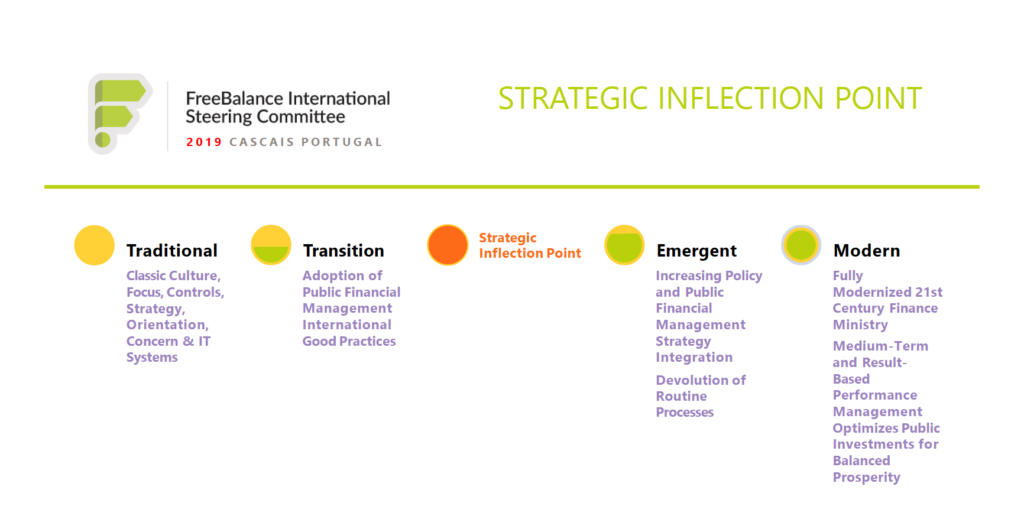
Edward Hedger of @NYUWagner: interesting #PFM space for emerging & developing countries esp around rapid #policy change pic.twitter.com/0mIxkbsFUZ
— Doug Hadden (@dalytics) May 9, 2019
The #policy in #PFM from this @NYUWagner symposium aligns with @IMFNews modern finance ministry paper https://t.co/PWdm8o0FCS
— Doug Hadden (@dalytics) May 9, 2019
.@SalamFayyad_pm: sometimes finance ministries so underfunded that can’t perform #PFM
— Doug Hadden (@dalytics) May 9, 2019
.@SalamFayyad_pm: separate planning departments complicate #PFM, what is a finance ministry multiple year budget if not a plan, we need to rethink this #PFMRethink
— Doug Hadden (@dalytics) May 9, 2019
Jens Kromann Kristensen of @PEFASecretariat: Ministers of Finance often lack #policy capacity or interest, yet key to integrating budgets with plans #PFMReform
— Doug Hadden (@dalytics) May 9, 2019
Jens Kromann Kristensen of @PEFASecretariat: #PEFA isn’t that powerful to be as gamed as many fear #PFMRethink
— Doug Hadden (@dalytics) May 9, 2019
3. Silos are the PFM villain
There was much discussion about the impact of government and donor silos in PFM reform. Donor technical assistance is often in silo specialization. Government PFM functions are often in silos. There is often poor communication among divisions within finance ministries. And, poor communications with SOEs, central banks and sub-national governments. The lack of integration among information systems also limits decision-making effectiveness.
Lesson: Finance ministries can be at the integration centre for decision-makers. And, the emerging smart and unified model of enterprise software design enables effective analytics with metadata and controls integration.
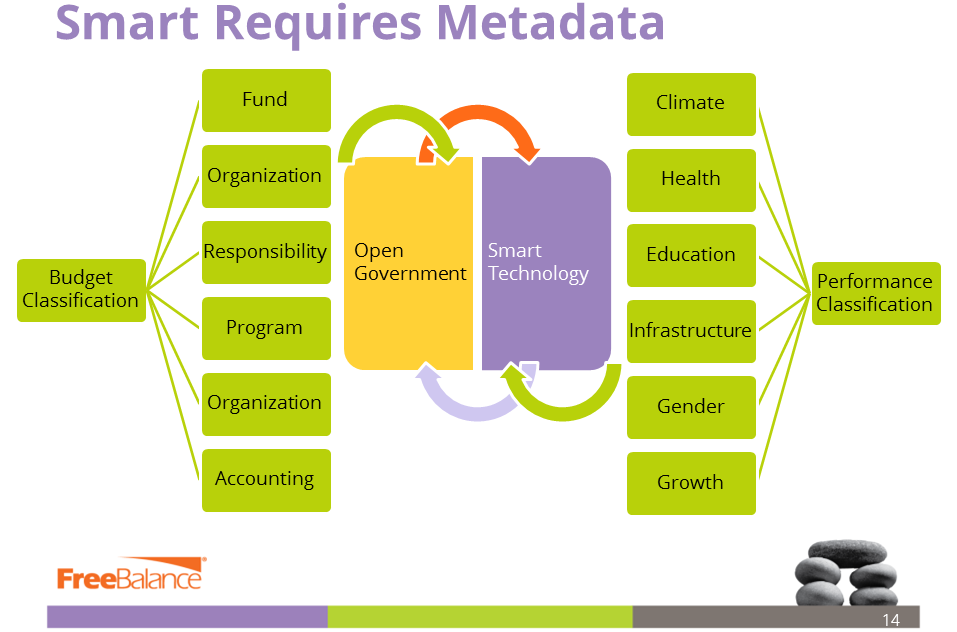
.@yorikomn: real need to collaborate with finance ministries with #health ministries for planning & budgeting, including bringing MOF staff into health departments to better understand context #PFM pic.twitter.com/dmM8mdPpkw
— Doug Hadden (@dalytics) May 9, 2019
Florence N. Kuteesa of @NYUWagner: missing shared commitment that #PFM needed to meet national goals, many do not understand the inter connectivity of issues – not happening b/c lack of fiscal discipline & #accountability
— Doug Hadden (@dalytics) May 9, 2019
Florence N. Kuteesa of @NYUWagner: #PFM often disconnected from results where idea that it’s up to line ministries to deliver outcomes, up to donors to define efficiency
— Doug Hadden (@dalytics) May 9, 2019
.@carorent: #PFM donor silos & government silos coordination can be enabled through increasing data availability & integration with budgets
— Doug Hadden (@dalytics) May 9, 2019
IMO: no technology reasons to prevent linkage of government #budget classifications to outputs & outcomes when systems properly integrated, but tech silos often get institutionalized #PFMRethink
— Doug Hadden (@dalytics) May 9, 2019
Chisom Okechukwu of @gatesfoundation: often the Ministry of Finance last to know about #health funding by donors & new initiatives b/c of silos #PFMRethink
— Doug Hadden (@dalytics) May 9, 2019
4. Agility needed for PFM success
PFM has been thought of as large multiple year interventions. “Best practices” are used to predict outcomes of PFM reform projects. Yet, many such project fail, especially in the implementation of Government financial systems. More agile approaches have emerged, such as Problem-Driven Iterative Adaption (PDIA) from the Harvard Kennedy School of Government. The key PDIA is that mimicking reform that worked elsewhere often results in failure because of differences in the country context.
Lessons: Country reform experimentation leveraging PDIA and lean techniques enable learning what works and scaling what works is emerging to improve reform success. Legacy thinking and legacy “waterfall” techniques need to be avoided.
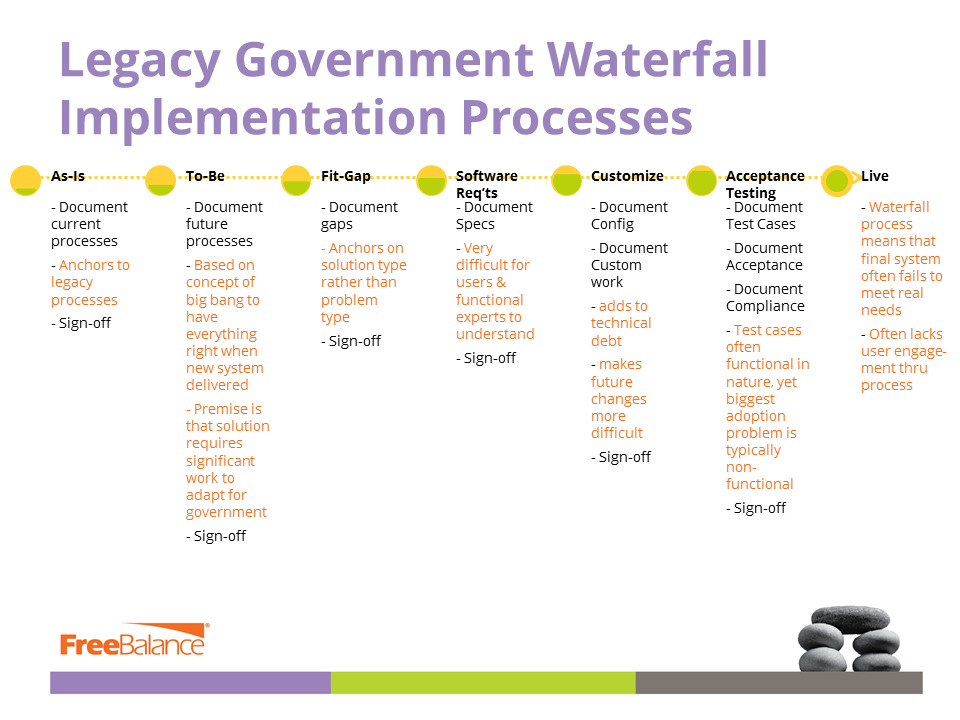
Jennifer Widner of @Princeton introduces successful #PFM interventions & persistent challenges, reports at https://t.co/SMRfvk0KQc pic.twitter.com/6U4U8F3VER
— Doug Hadden (@dalytics) May 9, 2019
Edward Hedger of @NYUWagner talks about problem-based diagnostics in #PFM (shows increased #pdia adoption, although with dialectic of #goodpractices)
— Doug Hadden (@dalytics) May 9, 2019
Florence N. Kuteesa of @NYUWagner: #PFM systems in #developingcountries mean understanding the cause of problems rather than symptoms such as budget credibility, fiscal #accountability – must look at the underlying conditions
— Doug Hadden (@dalytics) May 9, 2019
Nick Manning of @NYUWagner: #PFM #isomophism has gotten bad press, perhaps time to rethink
— Doug Hadden (@dalytics) May 9, 2019
.@SalamFayyad_pm: #PFM practitioners often succeed with practices that technical advisors would never recommend
— Doug Hadden (@dalytics) May 9, 2019
#PFMRethink Paper referenced by Jens Kromann Kristensen of @PEFASecretariat https://t.co/tBBFWFYB5Z
— Doug Hadden (@dalytics) May 9, 2019
Super-interesting comments from Ed Hedger on Public Financial Management, inc. whether the standard metrics used to assess PFM systems, + the way data is used, support the experimentation + learning that is needed. @ODIdev @NYUWagner @PrincetonISS @gatesfoundation
— Alan Hudson (@alanhudson1) May 9, 2019
5. Service delivery outcomes
PFM reform has shown good success in improving government fiscal discipline. But there is far less evidence that PFM improves service delivery. The symposium examine health delivery improvements through budget integration. These case studies from Princeton University point to a way forward, as did many of the takeaways from the recent World Bank and International Monetary Fund Spring meetings.
Lessons: Finance ministries can provide the missing link for measuring service delivery outcomes. This requires use of program budgeting techniques, and building outcome measurements. (Which is complex, see number 6.)

Paul Smoke of @NYUWagner overview of new #PFM public finance thinking such as @ODIdev linking PFM with service delivery
— Doug Hadden (@dalytics) May 9, 2019
Widner of @Princeton: #budget linkage to #health seems straightforward but challenges: #decentralization hinders collaboration, #insurance company incentives, integration with #IFMIS & linking performance to financial systems, #civilservice retention, #offbudget funding
— Doug Hadden (@dalytics) May 9, 2019
Florence Kuteesa, drawing on Uganda experience + more: When people recommend changes to PFM processes, without clarity + data about how changes will (+ do) affect outcomes, there’s a major accountability gap. [Ideology > evidence?] #PFMRethink
— Alan Hudson (@alanhudson1) May 9, 2019
6. Government Performance Management is hard
The difficulty of tracking outcomes in government, particularly service delivery (point 5), was discussed in detail. Governments in the case studies had more success tracking outputs. The inhibitors to tracking outcomes include lack of structures where ministries and agencies share programs. And, outcome metrics can’t be validated against an objective bottom line – like profit in the private sector. Government performance management is much more difficult than corporate performance management.
Lesson: Performance can be tracked in government when national objectives are aligned with budgets, and outputs and outcomes tracked to the point where the cost per unit of outcome is discovered – in other words, the ability to tie the performance dots together is technically complicated, where validating outcome measurements is far more complex
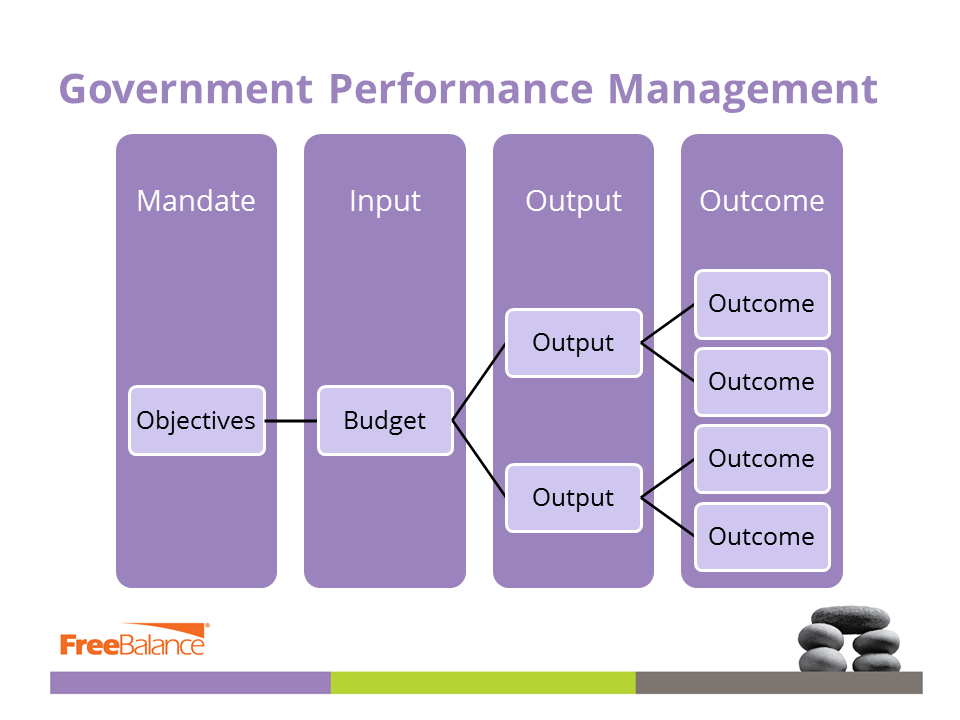
.@craighouseham: performance-based budgeting a #PFM ideal, need to relate spending with results & very difficult-start with basic systems, then look at priorities thru stability, then look at process effectiveness & upgrading systems to support this
— Doug Hadden (@dalytics) May 9, 2019
.@SalamFayyad_pm: should have transition to government performance-based budgeting, it isn’t magic & won’t take care of the kids while you go to the movies #PFMRethink
— Doug Hadden (@dalytics) May 9, 2019
7. Towards country-led development reform
It’s a sea change in development thinking: from foreign experts and donor-led to country-led development. As presented in Prosperity Paradox: How Innovation Can Lift Nations Out Of Poverty, and many other works. Countries that take control of the reform process have had better success. Many donors have seen the light. There is an increased suspicion of best practices and solutions out of context.
Lesson: Although many experts understand that context is critical, there remains an attraction to “proven solutions”, where approaches like PDIA seem extreme – what’s important to understand is that the approach enables teams to experiment with solution sets

#PFM symposium panel deals with change challenges pic.twitter.com/6G5HqdtZCv
— Doug Hadden (@dalytics) May 9, 2019
Florence N. Kuteesa of @NYUWagner: can’t implement #MTEF or cash management in #PFM without understanding why, what issues are to be addressed
— Doug Hadden (@dalytics) May 9, 2019
Verena Fritz of @wbg_gov: often a pattern of lingering reforms, could be better to find short windows of opportunity #PFMRethink
— Doug Hadden (@dalytics) May 9, 2019
.@carorent: governments need to drive #PFM reform to achieve results
— Doug Hadden (@dalytics) May 9, 2019
8. Less is more
What’s a government to do among so many PFM experts and so many reform opportunities? Professor Matt Andrews, at the Harvard Kennedy School, likens reform to a Christmas tree with many small ornaments. It’s better to have fewer but larger ornaments.
Lesson: Reform should be focused by addressing what’s important in countries – the country context, and respecting constraints in the form of governance gaps
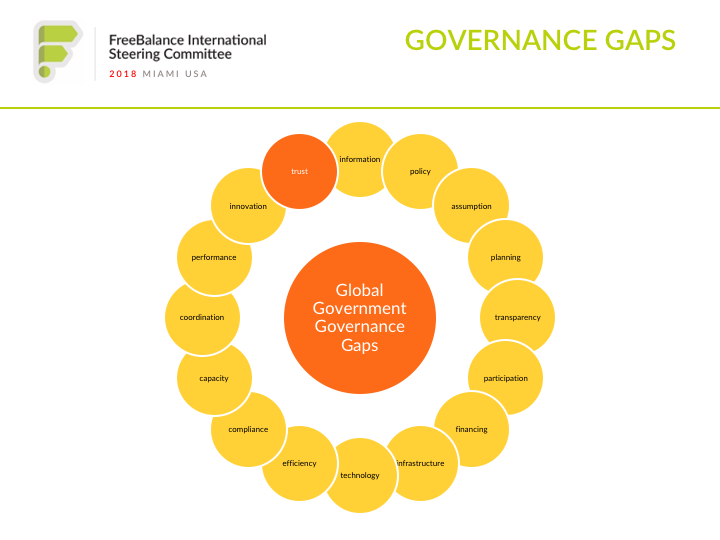
Marco Cangiano of @ODIdev: every donor competing in the #PFM space when institutions doing well for themselves but not necessarily for countries & has created silos: is HR & #procurement part of PFM?
— Doug Hadden (@dalytics) May 9, 2019
Florence N. Kuteesa of @NYUWagner: #corruption biggest incentive to achieve #PFM reform
— Doug Hadden (@dalytics) May 9, 2019
Marco Cangiano of @ODIdev: far too many #PFM experts out there, many are charlatans
— Doug Hadden (@dalytics) May 9, 2019
.@SalamFayyad_pm: when donors suggest #PFM reform, ask if they are using it and donor funding countries, like performance-based budgeting
— Doug Hadden (@dalytics) May 9, 2019
9. Innovation only when the basics addressed
Process and technical innovation has great promise. Consider the global PFM reform opportunity shown below. Many governments have had limited reform success to date. It’s unlikely that governments that have poor reform implementation records can succeed by levering Blockchain, the Internet of Things or Chatbots.
Lesson: Many countries have technology leapfrog potential, but innovation builds on basic building blocks
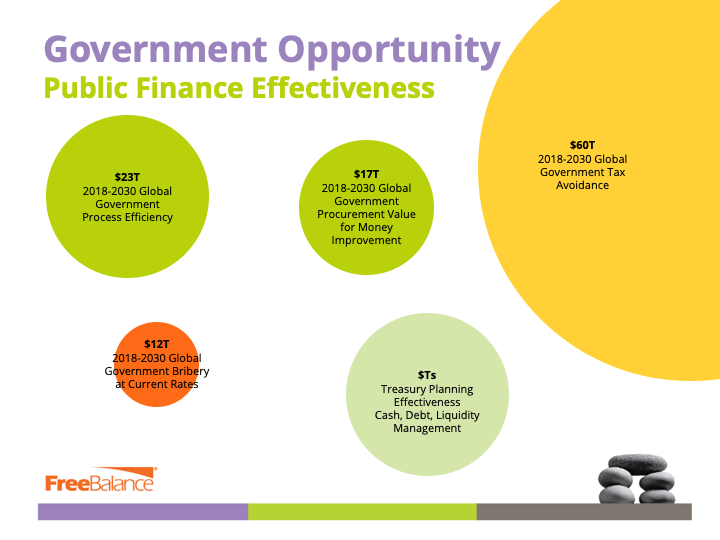
Verena Fritz of @wbg_gov: big #PFM reform problem where countries skip the basics to go after shiny exciting things like accrual accounting esp when donors prepared to fund, much overselling
— Doug Hadden (@dalytics) May 9, 2019
.@_miller_mark: great ideas on #PFM reform #innovation but real problem in government implementation of what we already have #PFMRethink
— Doug Hadden (@dalytics) May 9, 2019
10. Are IT systems part of the solution?
There was much discussion of the impact of financial systems in case studies. The existence of Integrated Financial Management Information Systems (IFMIS) – what we call Government Resource Planning (GRP), was described as a success factor in achieving service delivery outcomes. However, the coverage of GRP systems differed among health case studies where some countries did not have GRP integration.
Lessons: Few in the PFM community are technology experts. This can often lead to misleading conclusions. That’s because IFMIS is not a generic thing. Better conclusions can be reached about the impact of GRP to service delivery and PFM reform when we look at:
- Integrated coverage of financial systems, especially whether silos have been overcome
- Ability for systems to adapt to changing reform, what we call “progressive activation”
- Use of program budgeting and government performance measures in systems (as in point 6 above)
- Ability to extend beyond systems of record to new technology generations to support open government and more effective data collection for decision-making

.@yorikomn: rigidity of government line item budgeting prevents effectiveness, needs some level of discretion in #health spending
— Doug Hadden (@dalytics) May 9, 2019
.@yorikomn: need for government #health sector spending #accountability ties to outcomes, so need #budget capacity & information systems that provide effective information that is used for decision-making
— Doug Hadden (@dalytics) May 9, 2019
IMO: agree with #WorldBank questioner that government #GRP financial systems controls should be #riskbased, have tight controls on high risk #health items, discretion on others
— Doug Hadden (@dalytics) May 9, 2019
Verena Fritz of @wbg_gov: many expensive #MIS systems in governments are underutilized, utilization is critical need, monitor capacity gains #PFMRethink
— Doug Hadden (@dalytics) May 9, 2019
Summary
Perspective is everything in complex subjects like PFM reform. And, the incentives among stakeholders often reduce the potential of any reform. Donors get funds from contributing countries while loaning to others. PFM experts build careers through specialization. Vendors sell things. Government stakeholders often have political agendas.
Perverse incentives.
This symposium was another example of asking tough reform questions recognizing constraints. PFM reform is not all “gloom and doom”, there are many cases of reform success. I’m optimistic of even better success in the future.
Final @NYUWagner @ODIdev @Princeton #PFMRethink session: what have we learned & where next for #PFM? pic.twitter.com/5q5p3mkKyd
— Doug Hadden (@dalytics) May 9, 2019
